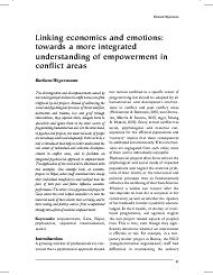Linking economics and emotions: towards a more integrated understanding of empowerment in conflict areas
The disintegration and disempowerment caused by war and organized violence in conflict areas are often reinforced by aid projects. Instead of addressing the social and psychological processes of threat andfear, destruction and trauma, loss and grief through interventions, they separate them, delegate them to specialists and ignore them in the other sectors of programming humanitarian aid. On the other hand, in psychosocial projects, the material needs of people are not always addressed adequately. In this article, a tool is introduced that helps to better understand the real extent of individual and collective disempowerment in conflict areas, and to facilitate an integrated psychosocial approach to empowerment. The application of this tool will be illustrated with two examples. One example looks at economic projects in Nepal, where staff examined more closely their individual beneficiaries and realized how the fears of both past and future influence economic performance. The other is in a psychosocial project in Gaza where this tool helped counsellors to take the material needs of their clients more seriously, and to turn sewing and pottery courses from occupational therapy into aform of economic empowerment. Keywords: empowerment, Gaza, Nepal, psychosocial, sequential traumatization, toolkit
Geachte bezoeker,
De informatie die u nu opvraagt, kan door psychotraumanet niet aan u worden getoond. Dit kan verschillende redenen hebben,
waarvan (bescherming van het) auteursrecht de meeste voorkomende is. Wanneer het mogelijk is om u door te verwijzen naar de bron
van deze informatie, dan ziet u hier onder een link naar die plek.
Als er geen link staat, kunt u contact opnemen met de bibliotheek,
die u verder op weg kan helpen.
Met vriendelijke groet,
Het psychotraumanet-team.
Reference:
Barbara Weyermann | 2007
In: Intervention: the international journal of mental health, psychosocial work and counselling in areas of armed conflict, ISSN 1571-8883 | 5 | 2 | 83-96
http://www.interventionjournal.com/sites/default/files/5.2.2.%20Weyermann.pdf
In: Intervention: the international journal of mental health, psychosocial work and counselling in areas of armed conflict, ISSN 1571-8883 | 5 | 2 | 83-96
http://www.interventionjournal.com/sites/default/files/5.2.2.%20Weyermann.pdf


